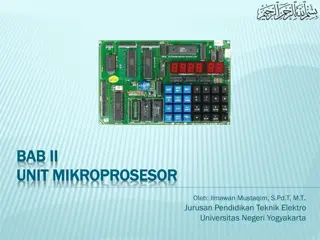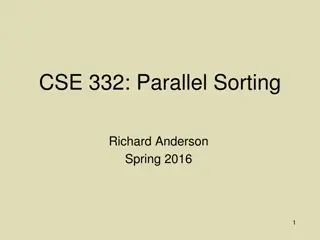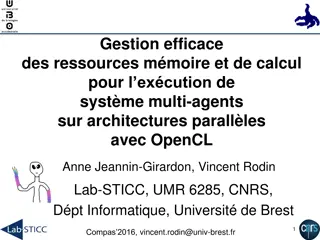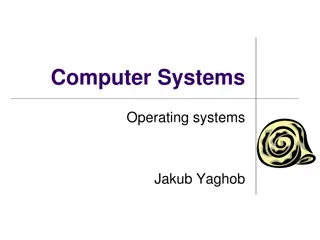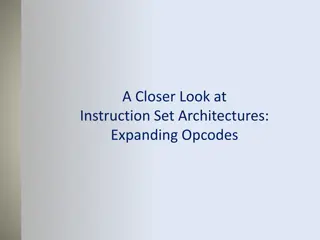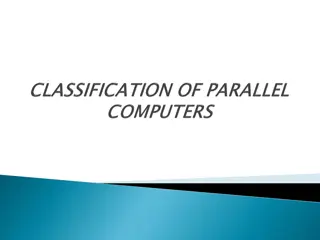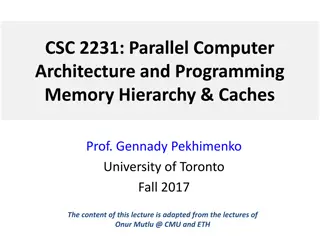Exploring Instruction Level Parallel Architectures in Embedded Computer Architecture
Delve into the intricacies of Instruction Level Parallel Architectures, including topics such as Out-Of-Order execution, Hardware speculation, Branch prediction, and more. Understand the concept of Speculation in Hardware-based execution and the role of Reorder Buffer in managing instruction results. Gain insights into OoO execution with speculation using RoB and its impact on processor efficiency.
- Embedded Computer Architecture
- ILP Architectures
- Out-Of-Order Execution
- Hardware Speculation
- Branch Prediction
Download Presentation

Please find below an Image/Link to download the presentation.
The content on the website is provided AS IS for your information and personal use only. It may not be sold, licensed, or shared on other websites without obtaining consent from the author. Download presentation by click this link. If you encounter any issues during the download, it is possible that the publisher has removed the file from their server.
E N D
Presentation Transcript
Embedded Computer Architecture 5SAI0 Instruction Level Parallel Architectures Part II Henk Corporaal www.ics.ele.tue.nl/~heco/courses/ECA TUEindhoven 2021-2022
Topics on ILP architectures Introduction, Hazards (short recap) Out-Of-Order (OoO) execution: Dependences limit ILP: dynamic scheduling Hardware speculation Branch prediction (finish) Multiple issue How much ILP is there? What can the compiler do? Material Ch 3 (H&P or Dubois, second part) But first coming back on Tomasulo 9/15/2024 ECA H.Corporaal 2
Speculation (Hardware based) Execute instructions along predicted execution paths but only commit the results if the prediction was correct Instruction commit: allowing an instruction to update the register file when instruction is no longer speculative Need an additional piece of hardware to prevent any irrevocable action until an instruction commits: Reorder buffer, or Large renaming register file why? think about it? 9/15/2024 ECA H.Corporaal 3
OoO execution with speculation using RoB NEW 9/15/2024 ECA H.Corporaal 4
Reorder Buffer (RoB) RoB holds the result of instruction between completion and commit Four fields per entry: 1. Instruction type: branch/store/register 2. Destination field: register number 3. Value field: output value 4. Ready field: completed execution? (is the data valid) Modify reservation stations: Operand source-id is now RoB (if its producer is still in the RoB) instead of functional unit (check yourself!) 9/15/2024 ECA H.Corporaal 5
Reorder buffer in operation Book: H&P sect 3.6 # refers to reorder buffer entry 9/15/2024 ECA H.Corporaal 6
Topics on ILP architectures Introduction, Hazards (short recap) Out-Of-Order (OoO) execution (H&P sect 3.4 - 3.6) Branch prediction (H&P sect 3.3+3.9) 1&2 bit prediction Branch correlation Avoiding branches: if-conversion Multiple issue (H&P sect 3.7 3.8) How much ILP is there? What can the compiler do? (H&P sect 3.2) Material Ch 3 (H&P or Dubois, second part) 9/15/2024 ECA H.Corporaal 7
Branch Prediction what is it? why do we need it? how does it work? various schemes 9/15/2024 ECA H.Corporaal 8
Branch Prediction Principles breq r1, r2, label // if r1==r2 // then PCnext = label // else PCnext = PC + 4 (for a RISC) Questions: do I jump ? where do I jump ? -> branch prediction -> branch target prediction what's the average branch penalty? <CPIbranch_penalty> i.e. how many instruction slots do I miss (or squash) due to branches 9/15/2024 ECA H.Corporaal 9
Branch Prediction & Speculation High branch penalties in pipelined processors: With about 20% of the instructions being a branch, the maximum ILP is five (but actually much less!) CPI = CPIbase + fbranch * fmisspredict * cycles_penalty Large impact if: Penalty high: long pipeline CPIbase low: for multiple-issue processors, Idea: predict the outcome of branches based on their history and execute instructions at the predicted branch target speculatively 9/15/2024 ECA H.Corporaal 10
Branch Prediction Schemes Predict branch direction: 1-bit Branch Prediction Buffer 2-bit Branch Prediction Buffer Correlating Branch Prediction Buffer Predicting next address: Branch Target Buffer Return Address Predictors + Or: try to get rid (some) of those malicious branches 9/15/2024 ECA H.Corporaal 11
1-bit Branch Prediction Buffer 1-bit branch prediction buffer or branch history table (BHT): PC 10 ..10 101 00 BHT 0 1 0 1 0 1 1 0 k-bits size=2k Buffer is like a cache without tags Does not help for our MIPS pipeline because target address calculations performed in same stage as branch condition calculation 9/15/2024 ECA H.Corporaal 12
Two 1-bit predictor problems PC 10 ..10 101 00 BHT 0 1 0 1 0 1 1 0 k-bits size=2k Aliasing: lower k bits of different branch instructions could be the same Solution: Use tags (the buffer becomes a tag); however very expensive Loops are predicted wrong twice Solution: Use n-bit saturation counter prediction * taken if counter 2 (n-1) * not-taken if counter < 2 (n-1) A 2-bit saturating counter predicts a loop wrong only once 9/15/2024 ECA H.Corporaal 13
2-bit Branch Prediction Buffer Solution: 2-bit scheme where prediction is changed only if mispredicted twice Can be implemented as a saturating counter, e.g. as following state diagram: T NT Predict Taken Predict Taken T T NT NT Predict Not Taken Predict Not Taken T NT 9/15/2024 ECA H.Corporaal 14
Next step: Correlating Branches Fragment from SPEC92 benchmark eqntott: if (aa==2) aa = 0; if (bb==2) bb=0; if (aa!=bb){..} subi R3,R1,#2 b1: bnez R3,L1 add R1,R0,R0 L1: subi R3,R2,#2 b2: bnez R3,L2 add R2,R0,R0 L2: sub R3,R1,R2 b3: beqz R3,L3 9/15/2024 ECA H.Corporaal 15
Correlating Branch Predictor 4 bits from branch address Idea: behavior of current branch is related to (taken/not taken) history of recently executed branches Then behavior of recent branches selects between, say, 4 predictions of next branch, updating just that prediction 2-bits per branch local predictors Prediction (2,2) predictor: 2-bit global, 2-bit local (k,n) predictor uses behavior of last k branches to choose from 2k predictors, each of which is n-bit predictor shift register, remembers last 2 branches 2-bit global branch history register (01 = not taken, then taken) 9/15/2024 ECA H.Corporaal 16
Branch Correlation: the General Scheme 4 parameters: (a, k, m, n) Pattern History Table 2m-1 n-bit m saturating Up/Down Counter 1 Prediction Branch Address 0 2k-1 0 1 k a Branch History Table (BHT) Table size (usually n = 2): Nbits = k * 2a + 2k * 2m *n mostly n = 2 9/15/2024 ECA H.Corporaal 17
Two varieties GA: Global history, a = 0 only one (global) history register correlation is with previously executed branches (often different branches) Variant: Gshare (Scott McFarling 93): GA which takes logic OR of PC address bits and branch history bits 1. PA: Per address history, a > 0 if a large almost each branch has a separate history so we correlate with the previous outcomes of the same branch 2. 9/15/2024 ECA H.Corporaal 18
Accuracy, taking the best combination of parameters (a, k, m, n) : GA (0,11,5,2) 98 PA (10, 6, 4, 2) Branch Prediction Accuracy (%) 97 96 95 94 Bimodal GAs PAs 93 92 91 89 64 128 256 1K 2K 4K 8K 16K 32K 64K Predictor Size (bytes) 9/15/2024 ECA H.Corporaal 19
Branch Prediction; summary Basic 2-bit predictor: For each branch: Predict taken or not taken If the prediction is wrong two consecutive times, change prediction Correlating (global history) predictor: Multiple 2-bit predictors for each branch One for each possible combination of outcomes of preceding n branches Local predictor: Multiple 2-bit predictors for each branch One for each possible combination of outcomes for the last n occurrences of this branch Tournament predictor: Combine correlating global predictor with local predictor 9/15/2024 ECA H.Corporaal 20
Branch Prediction Performance 9/15/2024 ECA H.Corporaal 21
Branch predition performance details for SPEC92 benchmarks 20% 18% 18% 16% 14% Mispredictions Rate Frequency of Mispredictions 12% 11% 10% 8% 6% 6% 6% 6% 5% 5% 4% 4% 2% 1% 1% 0% 0% 0% nasa7 matrix300 tomcatv doducd spice fpppp gcc espresso eqntott li 4,096 entries: 2-bits per entry 4096 Entries n = 2-bit BHT n = 2-bit BHT Unlimited entries: 2-bits/entry Unlimited Entries 1,024 entries (2,2) 1024 Entries (a,k) = (2,2) BHT 9/15/2024 ECA H.Corporaal 22
Branch Prediction Accuracy Mispredict because either: Wrong guess for that branch Got branch history of wrong branch when indexing the table (i.e. an alias occurred) 4096 entry table: misprediction rates vary from 1% (nasa7, tomcatv) to 18% (eqntott), with spice at 9% and gcc at 12% For SPEC92, 4096 entries almost as good as infinite table Real programs + OS are more like 'gcc' 9/15/2024 ECA H.Corporaal 23
Branch Target Buffer Predicting the Branch Condition is not enough !! Where to jump? Branch Target Buffer (BTB): each entry contains a Tag and Target address PC 10 ..10 101 00 Tag branch PC PC if taken Yes: instruction is branch. Use predicted PC as next PC if branch predicted taken. Branch prediction (often in separate table) =? No: instruction is not a branch. Proceed normally 9/15/2024 ECA H.Corporaal 24
Instruction Fetch Stage 4 Instruction register Instruction Memory PC BTB found & taken target address Not shown: hardware needed when prediction was wrong 9/15/2024 ECA H.Corporaal 25
Special Case: Return Addresses Register indirect branches: hard to predict target address MIPS instruction: jr r3 // this means: PCnext = (r3) implementing switch/case statements FORTRAN computed GOTOs procedure return (mainly): jr r31 on MIPS SPEC89: 85% of indirect branches used for procedure return Since stack discipline for procedures, save return address in small buffer that acts like a stack: 8 to 16 entries has already very high hit rate 9/15/2024 ECA H.Corporaal 26
Return address prediction: example 100 main: . 104 jal f 108 10C jr r31 main() { f(); } 120 f: 124 jal g 128 12C jr r31 f() { g() } 128 108 308 g: . 30C 310 jr r31 314 ..etc.. main ra return stack Q: when does the return stack predict wrong? 9/15/2024 ECA H.Corporaal 27
Or: ..?? Avoid branches ! 9/15/2024 ECA H.Corporaal 28
Predicated Instructions (discussed before) Avoid branch prediction by turning branches into conditional or predicated instructions: If false, then neither store result nor cause exception Expanded ISA of Alpha, MIPS, PowerPC, SPARC have conditional move; PA-RISC can annul any following instr. IA-64/Itanium: conditional execution of any instruction Examples: if (R1==0) R2 = R3; CMOVZ R2,R3,R1 if (R1 < R2) R3 = R1; else R3 = R2; SLT CMOVNZ R3,R1,R9 CMOVZ R3,R2,R9 R9,R1,R2 9/15/2024 ECA H.Corporaal 29
General guarding: if-conversion if (a > b) { r = a % b; } else { r = b % a; } y = a*b; 4 basic blocks sub t1,a,b bgz t1,then else: rem r,b,a j next then: rem r,a,b next: mul y,a,b 1 sub t1, a, b bgz t1, 2, 3 CFG: 2 rem r, a, b goto 4 3 rem r, b, a goto 4 if-conversion 1 basic block 4 mul y,a,b .. sub t1,a,b t1 rem r,a,b !t1 rem r,b,a mul y,a,b Guards t1 & !t1 9/15/2024 ECA H.Corporaal 30
Dynamic Branch Prediction: Summary Prediction important part of scalar execution Branch History Table: 2 bits for loop accuracy Correlation: Recently executed branches correlated with next branch Either correlate with previous branches Or different executions of same branch Branch Target Buffer: include branch target address (& prediction) Return address stack for prediction of indirect jumps Or .avoid branches: if-conversion 9/15/2024 ECA H.Corporaal 31
Topics on ILP architectures Introduction, Hazards (short recap) Out-Of-Order (OoO) execution: Branch prediction Multiple issue Superscalar VLIW TTA (not in H&P) How much ILP is there? What can the compiler do? Material Ch 3 (H&P or Dubois, second part) 9/15/2024 ECA H.Corporaal 32
Going Parallel: Multiple Instructions Combined with OOO Issue multiple instructions (or operations) per cycle
Going parallel: Multiple Issue Multiple parallel pipelines: CPI can get < 1 complete multiple instructions per clock Two Options: Statically scheduled superscalar processors VLIW (Very Long Instruction Word) processors Dynamically scheduled superscalar processors Superscalar processor EPIC (explicit parallel instruction computer) somewhat in between 9/15/2024 ECA H.Corporaal 34
Multiple Issue Options: Most used 9/15/2024 ECA H.Corporaal 35
Modern Superscalar Modern (superscalar) microarchitectures = Dynamic scheduling + Multiple Issue + Speculation Issue logic can become bottleneck Several approaches: Assign reservation stations and update pipeline control table in half a clock cycle Only supports 2 instructions/clock Design logic to handle any possible dependencies between the instructions Hybrid approaches 9/15/2024 ECA H.Corporaal 36
Multiple Issue: reduce complexity Limit the number of instructions of a given class that can be issued in a bundle I.e. one FloatingPt, one Integer, one Load, one Store Examine all the dependencies among the instructions in the bundle If dependencies exist in bundle, encode them in reservation stations Need multiple completions&commits per cycle 9/15/2024 ECA H.Corporaal 37
Example: increment array elements Loop: LD R2, 0(R1) ;R2=array element ;increment R2 ;store result ;increment R1 to point to next double ;branch if not final iteration DADDIU R2, R2,#1 SD R2, 0(R1) DADDIU R1, R1, #8 BNE R2, R3, Loop 9/15/2024 ECA H.Corporaal 38
Example (No Speculation) Note: LD following BNE must wait on the branch outcome (no speculation)! ECA H.Corporaal 9/15/2024 39
Example (with branch Speculation) Note: Execution of 2nd DADDIU is earlier than 1th, but commits later, i.e. in order! ECA H.Corporaal 9/15/2024 40
Nehalem microarchitecture (Intel) first use: Core i7 2008 45 nm hyperthreading shared L3 cache 3 channel DDR3 controler QIP: quick path interconnect 32K+32K L1 per core 256 L2 per core 4-8 MB L3 shared between cores 9/15/2024 ECA H.Corporaal 41
Limitations of OoO Superscalar Available ILP is limited usually we re not programming with parallelism in mind Huge hardware cost when increasing issue width adding more functional units is easy, however: more memory ports and register ports needed dependency check needs O(n2) comparisons renaming needed complex issue logic (check and select ready operations) complex forwarding circuitry Any cheaper alternatives ??? 9/15/2024 ECA H.Corporaal 42
VLIW: alternative to Superscalar Hardware much simpler!! Why?? Limitations of VLIW processors Very smart compiler needed (but largely solved!) Loop unrolling helps but increases code size Unfilled slots waste instruction bits (need NOPs) Cache miss stalls whole pipeline Research topic: scheduling loads Binary incompatibility (.. can partly be solved: EPIC or JITC .. ) Note: Still many ports on register file needed Complex forwarding circuitry and many bypass buses Solve these issues later 9/15/2024 ECA H.Corporaal 43
Single Issue RISC vs Superscalar op op op op op op op op op op op op instr instr instr instr instr instr instr instr instr instr instr instr op op op op op op op op op op op op instr instr instr instr instr instr instr instr instr instr instr instr Change HW, but can use same code issue and (try to) execute 3 instr/cycle execute 1 instr/cycle 3-issue Superscalar (1-issue) RISC CPU 9/15/2024 ECA H.Corporaal 44
Single Issue RISC vs VLIW op op op op op op op op op op op op instr instr instr instr instr instr instr instr instr instr instr instr instr instr instr instr instr op nop op op op op op op nop op op op nop op op Compiler execute 1 instr/cycle 3 ops/cycle execute 1 instr/cycle 3-issue VLIW RISC CPU 9/15/2024 ECA H.Corporaal 45
VLIW: general concept Instruction Memory A VLIW architecture with 7 FUs Instruction register Function units Int FU Int FU Int FU LD/ST LD/ST FP FU FP FU Floating Point Register File Int Register File Data Memory 9/15/2024 46
VLIW characteristics Multiple operations per instruction One instruction per cycle issued (at most) Compiler is in control Only RISC like operation support Short cycle times Easier to compile for Flexible: Can implement any FU mixture Extensible / Scalable add sub sll nop bne Example VLIW instructions However: tight inter FU connectivity required not binary compatible !! (new long instruction format) low code density 9/15/2024 47
VelociTI C6x datapath 9/15/2024 48
VLIW example: TMS320C62 TMS320C62 VelociTI Processor 8 operations (of 32-bit) per instruction (256 bit) Two clusters 8 Fus: 4 Fus / cluster : (2 Multipliers, 6 ALUs) 2 x 32 registers One bus available to write in register file of other cluster Flexible addressing modes (like circular addressing) Flexible instruction packing All instruction conditional Originally: 5 ns, 200 MHz, 0.25 um, 5-layer CMOS 128 KB on-chip RAM 9/15/2024 49
VLIW example: Philips TriMedia TM1000 Register file (128 regs, 32 bit, 15 ports) 5 constant 5 ALU 2 memory 2 shift 2 DSP-ALU 2 DSP-mul 3 branch 2 FP ALU 2 Int/FP ALU 1 FP compare 1 FP div/sqrt Data cache (16 kB) Exec unit Exec unit Exec unit Exec unit Exec unit Instruction register (5 issue slots) Instruction cache (32kB) PC 9/15/2024 50



